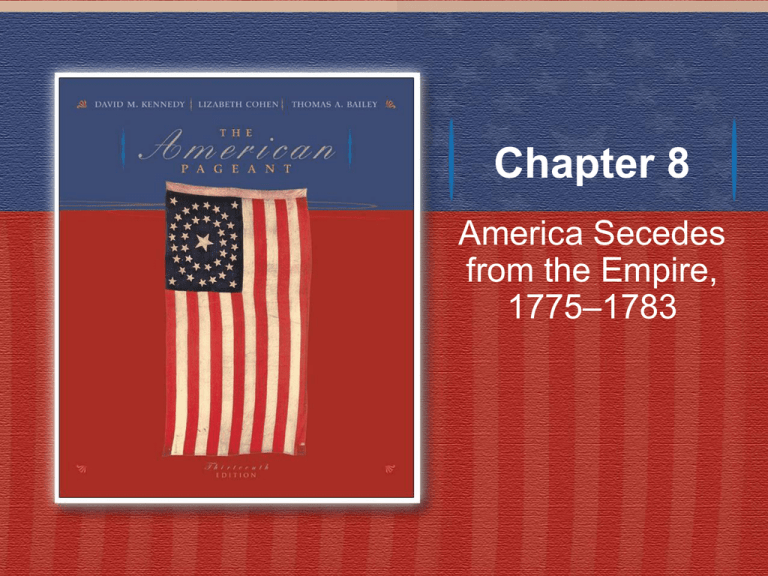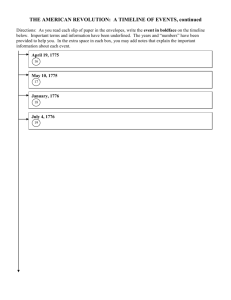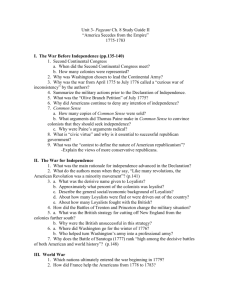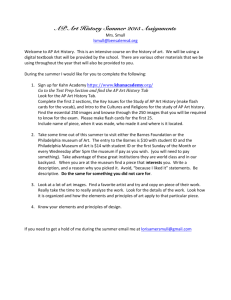
Chapter 8
America Secedes
from the Empire,
1775–1783
Washington at Verplanck’s Point,
New York, 1782, Reviewing the
French Troops After the Victory
at Yorktown, by John Trumbull,
1790
This noted American artist accentuated
Washington’s already imposing height
(six feet two inches) by showing him
towering over his horse. Washington so
appreciated this portrait of himself that
he hung it in the dining room of his
home at Mount Vernon, Virginia.
Winterthur Museum
Battle of Bunker Hill, June 17, 1775
This British engraving conveys the vulnerability of the British regulars to attacks by
the American militiamen. Although a defeat for the colonists, the battle quickly proved
a moral victory for the Patriots. Outnumbered and outgunned, they held their own
against the British and suffered many fewer casualties.
The Granger Collection
Revolution in the North, 1775–1776
Benedict Arnold’s troops were described as “pretty young men” when they sailed from
Massachusetts. They were considerably less pretty on their arrival in Quebec, after
eight weeks of struggling through wet and frigid forests, often without food. “No one
can imagine,” one of them wrote, “the sweetness of a roasted shot-pouch
[ammunition bag] to the famished appetite.”
Copyright (c) Houghton Mifflin Company. All Rights Reserved.
George III (1738–1820), Studio of
Alan Ramsay, c. 1767
America’s last king, he was a good
man, unlike some of his scandal-tainted
brothers and sons, but a bad king.
Doggedly determined to regain arbitrary
power for the crown, he antagonized
and then lost the thirteen American
colonies. During much of his sixty-year
reign, he seemed to be insane, but
recently medical science has found that
he was suffering from a rare metabolic
and hereditary disease called porphyria.
National Portrait Gallery, London
Loyalists Take Flight
This watercolor shows an encampment on the St. Lawrence River of Loyalists who
had fled the rebellious colonies for the safe haven of Canada, where they applied to
the British government for land grants.
Library and Archives Canada Acc. No. 1989-218-1
Loyalists Through British Eyes
This British cartoon depicts the Loyalists as doubly victimized--by Americans
caricatured as “savage” Indians and by the British prime minister, the Earl of
Shelburne, for offering little protection to Britain’s defenders.
New York Public Library
New York Patriots Pull Down the Statue of King George III
Erected after the repeal of the Stamp Act in 1766, this statue was melted down by the
revolutionaries into bullets to be used against the king’s troops.
Lafayette College
Washington Crossing the Delaware, by Emanuel Gottlieb Leutze, 1851
On Christmas Day, 1776, George Washington set out from Pennsylvania with twenty-four hundred men to surprise
the British forces, chiefly Hessians, in their quarters across the river in New Jersey. The subsequent British defeat
proved to be a turning point in the Revolution, as it checked the British advance toward Philadelphia and restored
American morale. Seventy-five years later, Leutze, a German American immigrant who had returned to Germany,
mythologized the heroic campaign in this painting. Imbued with the liberal democratic principles of the American
Revolution, Leutze intended his painting to inspire Europeans in their revolutions of 1848. To that end, he ignored
the fact that the Stars and Stripes held by Lieutenant James Monroe was not adopted until 1777; that Washington
could not possibly have stood so long on one leg; that the colonists crossed the Delaware at night, not during the
day; and that no African American would have been present. What Leutze did capture was the importance of
ordinary men in the Revolutionary struggle and the tremendous urgency they felt at this particular moment in 1776,
when victory seemed so elusive.
The Metropolitan Museum of Art, Gift of John Stewart Kennedy, 1897 (97.34) Photograph © 1992 The Metropolitan
Museum of Art
New York–Pennsylvania Theater,
1777–1778
Distinguished members of the
Continental Congress fled from
Philadelphia in near-panic as the British
army approached. Thomas Paine
reported that at three o’clock in the
morning, the streets were “as full of
Men, Women, and Children as on a
Market Day.” John Adams had
anticipated that “I shall run away, I
suppose, with the rest,” since “we are
too brittle ware, you know, to stand the
dashing of balls and bombs.” Adams
got his chance to decamp with the
others into the interior of Pennsylvania
and tried to put the best face on things.
“This tour,” he commented, “has given
me an opportunity of seeing many parts
of this country which I never saw
before.”
Copyright (c) Houghton Mifflin Company. All Rights Reserved.
Revolutionary Standard of the Light-Horse of the City of Philadelphia,
by John Folwell and James Claypoole, 1775
Silk flags like this were used to identify military units. In an exercise known as
“trooping the colors,” such flags were regularly paraded before the troops so that
soldiers could recognize their own units in the confusion of battle.
First Troop Philadelphia City Calvary Museum
Benjamin Franklin (1706–1790),
by Charles Willson Peale, 1789
Benjamin Franklin left school at age ten
and became a wealthy businessman, a
journalist, an inventor, a scientist, a
legislator, and preeminently a
statesman diplomat. He was sent to
France in 1776 as the American envoy
at age seventy, and he remained there
until 1785, negotiating the alliance with
the French and helping to negotiate the
treaty of peace. His fame had preceded
him, and when he discarded his wig for
the fur cap of a simple “American
agriculturist,” he took French society by
storm. French aristocratic women, with
whom he was a great favorite, honored
him by adopting the high coiffure a la
Franklin in imitation of his cap.
Courtesy of the Historical Society of Pennsylvania Collection, Atwater Kent Museum of Philadelphia
War in the South, 1780–1781
The southern war, after the British invasion of Georgia in late 1778, was characterized
by a series of British thrusts into the interior, leading to battles with American
defenders in both North and South Carolina. Finally, after promising beginnings,
Cornwallis's foray into Virginia ended with disaster at Yorktown in October 1781.
Copyright (c) Houghton Mifflin Company. All Rights Reserved.
George Rogers Clark’s Campaign, 1778–1779
The elder brother of famed explorer William Clark, George Rogers Clarke was the
greatest American military campaigner of the Revolutionary War in the Northwest
Territories. His victories at Kaskaskia (1778) and Vincennes (1779) greatly weakened
British control in the area.
Copyright (c) Houghton Mifflin Company. All Rights Reserved.
The Reconciliation Between
Britannia and Her Daughter
America (detail)
America (represented by an Indian) is
invited to buss (kiss) her mother.
The New York Public Library



